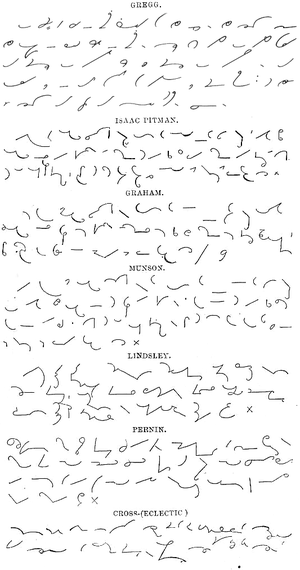
Back Snelskrif Afrikaans كتابة مختزلة Arabic Stenoqrafiya Azerbaijani Стэнаграфія Byelorussian Стэнаграфія BE-X-OLD Стенография Bulgarian সাঁটলিপি Bengali/Bangla Taquigrafia Catalan Těsnopis Czech Stenografi Danish


Shorthand is an abbreviated symbolic writing method that increases speed and brevity of writing as compared to longhand, a more common method of writing a language. The process of writing in shorthand is called stenography, from the Greek stenos (narrow) and graphein (to write). It has also been called brachygraphy, from Greek brachys (short), and tachygraphy, from Greek tachys (swift, speedy), depending on whether compression or speed of writing is the goal.
Many forms of shorthand exist. A typical shorthand system provides symbols or abbreviations for words and common phrases, which can allow someone well-trained in the system to write as quickly as people speak. Abbreviation methods are alphabet-based and use different abbreviating approaches. Many journalists use shorthand writing to quickly take notes at press conferences or other similar scenarios. In the computerized world, several autocomplete programs, standalone or integrated in text editors, based on word lists, also include a shorthand function for frequently used phrases.
Shorthand was used more widely in the past, before the invention of recording and dictation machines. Shorthand was considered an essential part of secretarial training and police work and was useful for journalists.[1] Although the primary use of shorthand has been to record oral dictation and other types of verbal communication, some systems are used for compact expression. For example, healthcare professionals might use shorthand notes in medical charts and correspondence. Shorthand notes were typically temporary, intended either for immediate use or for later typing, data entry, or (mainly historically) transcription to longhand. Longer-term uses do exist, such as encipherment: diaries (like that of Samuel Pepys) are a common example.[2]
- ^ McCay, Kelly Minot. " All the World Writes Short Hand": The Phenomenon of Shorthand in Seventeenth-Century England." Book History 24, no. 1 (2021): 1-36.
- ^ Pepys, Samuel; Latham, Robert; Matthews, William (1970), The diary of Samuel Pepys: a new and complete transcription, Bell & Hyman, ISBN 978-0-7135-1551-0, Volume I, pp. xlvii–liv (for Thomas Shelton's shorthand system and Pepys' use of it)